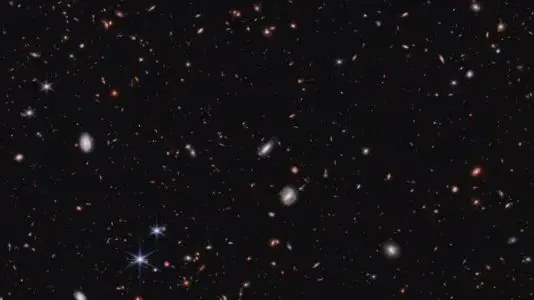
James Webb Space Telescope's Shocking Discovery: Could Dark Matter Be an Illusion?
2024-11-12
Author: Charlotte
James Webb Space Telescope's Shocking Discovery: Could Dark Matter Be an Illusion?
In an exciting breakthrough, astronomers utilizing the James Webb Space Telescope (JWST) have revealed that some of the oldest galaxies in the universe appear significantly larger and brighter than previously anticipated. This unexpected observation raises intriguing questions about the role of dark matter in galaxy formation and hints at a potential alternative theory known as modified Newtonian dynamics, or MOND.
Astrophysicist Stacy McGaugh from Case Western Reserve University emphasized a surprising departure from established cosmic theories. "We expected that the massive galaxies we observe nearby would have originated from tiny fragments," McGaugh remarked. "What dark matter theories predict does not match what we observe."
The prevailing theory of galaxy formation relies on the concept of cold dark matter, which suggests a gradual accumulation of mass over time, leading to the diverse shapes and sizes of galaxies that populate our universe. This theory has long been the cornerstone of cosmological models. However, JWST data has yet to show the faint signals indicative of the primordial galaxy fragments that conventional theory would expect to find. Instead, researchers have uncovered evidence that early galaxies were thriving far beyond predicted sizes and luminosities, contradicting the expectations set forth by traditional cold dark matter models.
The implications of this rapid growth align closely with the predictions of MOND, a theory proposing that gravity operates differently at extremely low accelerations—a condition commonly found at the fringes of galaxies. First introduced by Israeli physicist Mordehai Milgrom in 1982, MOND challenges the standard assertions of dark matter's existence, arguing that the faster-than-expected rotational speeds of galaxies can be explained without resorting to unseen mass.
Despite this promising alignment with observational data, MOND remains a contentious theory among scientists. Many argue that integrating it into a coherent cosmological framework remains a challenge. By contrast, while the dark matter paradigm fits a wide range of cosmic observations, it fails to satisfactorily account for several phenomena where MOND shines.
In their published study, McGaugh and colleagues articulated their conundrum: "We find ourselves caught between two very different theories that seem irreconcilable despite applying to closely related yet incommensurate lines of evidence." They are urged by their findings to take MOND seriously, asserting, "It must be telling us something, though what that is remains as enigmatic as the true nature of dark matter."
This extraordinary development invites speculation about the fundamental structure of the universe. Could the longstanding belief in dark matter be fundamentally flawed? As scientists continue to analyze data from JWST, the potential for paradigm shifts in our understanding of cosmic evolution beckons. Keep your eyes on the skies—our universe might be much stranger than we ever imagined!









 Brasil (PT)
Brasil (PT)
 Canada (EN)
Canada (EN)
 Chile (ES)
Chile (ES)
 España (ES)
España (ES)
 France (FR)
France (FR)
 Hong Kong (EN)
Hong Kong (EN)
 Italia (IT)
Italia (IT)
 日本 (JA)
日本 (JA)
 Magyarország (HU)
Magyarország (HU)
 Norge (NO)
Norge (NO)
 Polska (PL)
Polska (PL)
 Schweiz (DE)
Schweiz (DE)
 Singapore (EN)
Singapore (EN)
 Sverige (SV)
Sverige (SV)
 Suomi (FI)
Suomi (FI)
 Türkiye (TR)
Türkiye (TR)